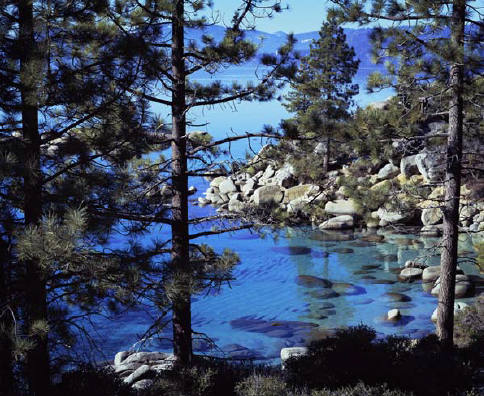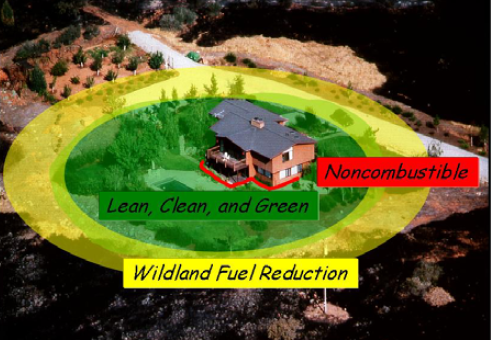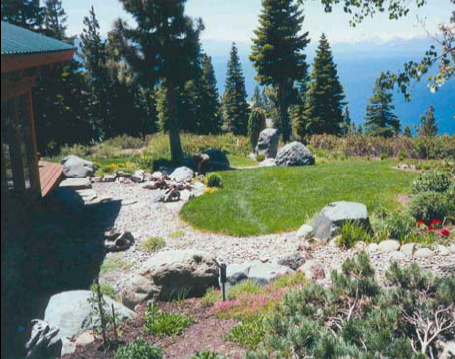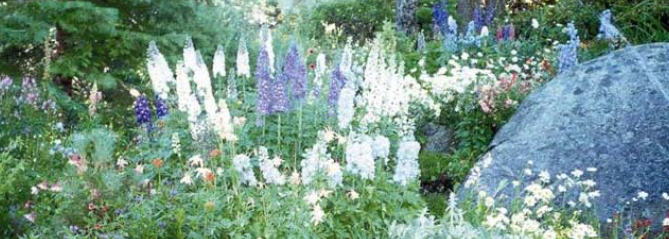How to Create Defensible Space for Your Home While Protecting Lake Tahoe
Homeowners at Lake Tahoe need to protect their homes from wildfire. At the same time, they are required to protect Lake Tahoe’s famed water clarity from sediment caused by soil erosion. These goals can be accomplished most efficiently if owners plan their defensible space and their best management practices (BMPs) together in an integrated fashion.

Photo by J.T. Ravizé
In a Nutshell
Defensible space is the area between a house and an oncoming wildfire where the vegetation should be managed to reduce the wildfire threat and allow firefighters to safely defend the house. Within the defensible space area, the homeowner should remove dead shrubs and trees, prune ladder fuels (low branches and shrubs under trees), create a separation between dense vegetation and plant less flammable vegetation.
Best Management Practices (BMPs) are required methods to prevent soil erosion and to infiltrate roof and driveway runoff into the ground. Bare soil and sloping ground should be covered with a mosaic of native and/or adapted plants and mulch. Steep slopes over 50 percent may require stabilization structures such as terraces or rocks, in addition to vegetation.
Widespread use of organic mulches (wood or bark chips) within 30 feet of structures is not recommended. Mulched areas should be separated from the house and from each other by noncombustible materials and open areas to prevent the rapid travel of fire across this area.

The Noncombustible Area extends 5 feet from the structure. The Lean, Clean and Green Area extends at least 30 feet.
Tips for Integrating BMPs and Defensible Space
- Cut down and remove dead trees and shrubs, but leave the roots in place, if practical.
- Prune live shrubs aggressively.
- If plant removal results in patches of exposed soil, revegetate those areas as described below.
- Choose low growing, irrigated, herbaceous (non‐woody) plants such as lawn, erosion control grasses, flowers or succulents to create a Lean, Clean and Green Area within 30 feet of your home. When these plants turn brown in late summer, they should be mowed down and the stalks should be removed.
- Within 5 feet of the house, create a Noncombustible Area using inorganic mulch (gravel or rocks); lowgrowing, irrigated herbaceous vegetation; and other materials that cannot be easily ignited. Do not allow pine needles to accumulate in this area. Gravel mulch or riprap should be placed under decks.
- When breaking up dense brush fields on steep slopes, create small groups or “islands” of pruned shrubs staggered horizontally across the slope.

Both BMPs and Defensible Space are required on developed property in the Tahoe Basin. The landscape above integrates these practices in a beautiful manner.
A Note About Pine Needles
- Remove fallen needles and leaves from the Lean, Clean and Green Area once each year in the spring.
- Regularly rake up and compost or recycle needles and leaves that have accumulated in the 5 foot noncombustible area and on surfaces such as decks, rooftops, roof gutters, lawns, flower beds and pavement.
- Do not allow thick layers (greater than 3 inches) of pine needles to accumulate anywhere on your property.
What About Bare Soil?
- Some bare soil is permissible after raking needles in the spring.
- If bare soil presents a substantial risk of erosion and delivery of sediment off site (off your property), a full Certificate of BMP Completion may not be issued.
- In this case, work with your Conservation District or TRPA to control the risk of erosion in areas of bare soil.
- If a later inspection shows an erosionfree Lean, Clean, and Green Area as described on the previous panel, a full Certificate of BMP Completion will be issued.
For more information:
- For assistance in designing your BMPs and a free copy of the “Home Landscaping Guide for Lake Tahoe,” call the Conservation District in California, (530) 543‐1501, ext. 113 (TAHOE); or in Nevada, (775) 586 ‐1610, ext. 28 (NTCD). You can also visit TRPA.
- See Chapters 3, 5 and 7 of the “Home Landscaping Guide for Lake Tahoe” for details about installing your BMPs and defensible space.
- You can obtain a hard copy of the new 2nd edition of the publication, “Living with Fire, A Guide for the Homeowner—Lake Tahoe Basin,” from local fire protection districts or fire safe council chapters. The publication can also be viewed at Living with Fire.

Cobourn, John
2008,
Combine Defensible Space and Best Management Practices (BMP's),
Extension | University of Nevada, Reno, FS-08-26


